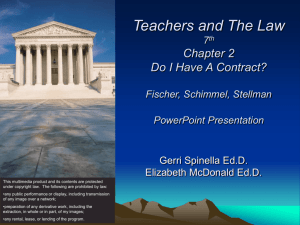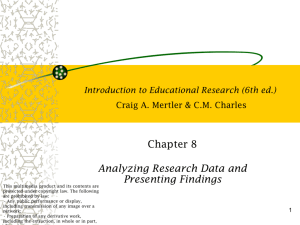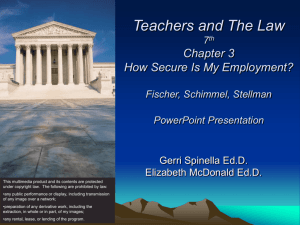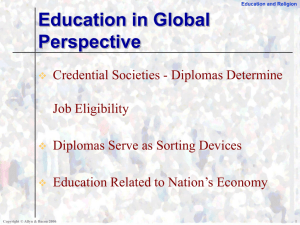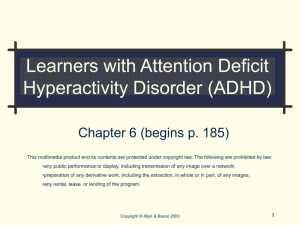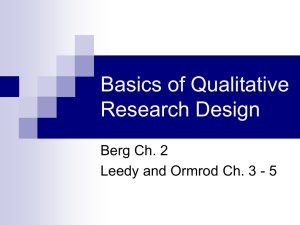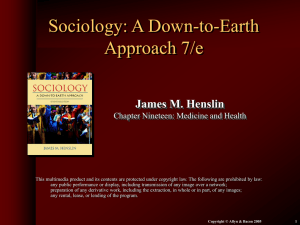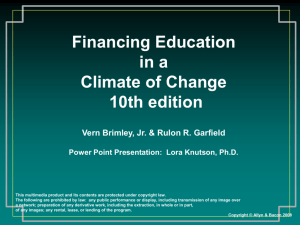Chapter 18
advertisement
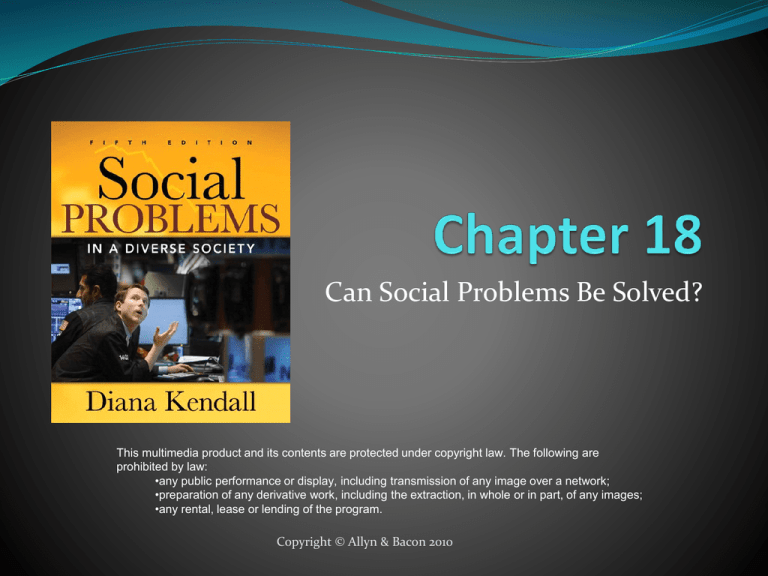
Can Social Problems Be Solved? This multimedia product and its contents are protected under copyright law. The following are prohibited by law: •any public performance or display, including transmission of any image over a network; •preparation of any derivative work, including the extraction, in whole or in part, of any images; •any rental, lease or lending of the program. Copyright © Allyn & Bacon 2010 Chapter Outline Social Change • Microlevel attempts • Midrange attempts • Macrolevel attempts Groups and movements • Special interest groups • Collective behavior • Types of social movements Sociological Perspectives • Functionalist • Conflict • Interactionist Copyright © Allyn & Bacon 2010 Problem with Tackling Social Problems Ideal vs. Practical Solutions Conflict between ideal solutions and the workable one Preventive measures are costly and are often allocated a small percentage of money and resources New Orleans and Hurricane Katrina We usually rely on after-the-fact measures to deal with both natural and social disasters Defining the Problem vs. Fixing it No agreement about what the problem is and what it needs to fix it Those who identify it usually don’t fix it Copyright © Allyn & Bacon 2010 Social Change and Reducing Social Problems Social change is the transformation of public policy, culture or social institutions over time Obstacles, delays, and frustrations confront those who attempt social change Solving a social problem can entail short-term, middle-term or long-term efforts Copyright © Allyn & Bacon 2010 Microlevel Attempts to Solve Social Problems Focus on how individuals operate within small groups to solve problems Primary groups: face to face emotion based interactions Focus on how individuals can do something about the problems they face. Limitation: Fails to consider that secondary groups and institutions play a major part in creating, maintaining, and exacerbating many social problems Copyright © Allyn & Bacon 2010 Midrange Attempts to Solve Social Problems Focus on how secondary groups and formal organizations deal with problems such as drug addiction Grassroots groups often work to change a perceived wrong Mid-range attempts are based on 2 things: Some social problems can best be reduced by reaching one person at a time Prevention and intervention are most effective at the personal and community levels. Limitation: Local efforts usually lack the capacity to produce the larger changes needed at the national or international levels Copyright © Allyn & Bacon 2010 Macro-Level Attempts to Deal with Social Problems Focus on how large-scale institutions (e.g., government) may become involved in remedies Powerless individuals bind together to in organizations to influence those at the national or global level. Limitations: Overemphasizes structural barriers in society, making them appear insurmountable De-emphasizes the importance of individual responsibility Copyright © Allyn & Bacon 2010 Working Through Special Interest Groups Special Interest Groups: Political coalitions designed to protect or advance specific issues Can be categorized on the basis of 3 factors: 1. Issues Single issue versus multiple demands 2. View of the present system of wealth and power Radical demands versus reform 3. Beliefs about elites Whether to influence them or replace them Copyright © Allyn & Bacon 2010 Working Through Social Movements Collective Behavior Voluntary, often spontaneous activity of a large number of people and typically violates group norms and values Riots and public demonstrations Civil Disobedience Collective behavior that is nonviolent and seeks to change a policy or law by refusing to comply with it 1960s Civil Rights Movement and protest crowds Copyright © Allyn & Bacon 2010 Types of Movements Reform movements Change specific aspect of social structure Revolutionary Bring about total change in society. Religious movements Renovate or renew people through inner change Alternative movements Seek limited change in some aspect of people’s behavior Resistance movements Prevent change or undo change that has occurred. Copyright © Allyn & Bacon 2010 Functionalist Perspective Social problems arise when social institutions do not fulfill their functions or when dysfunctions occur Solution: Social institutions need to be more effective Prevention of rapid social change Maintenance of status quo Restoration of order Copyright © Allyn & Bacon 2010 Conflict Perspective Conflict is natural and inevitable in society. Conflict occurs because of values held by divergent groups in society. Solutions: Patriarchy, capitalism must be radically altered or eliminated. Dramatic changes in society giving minority groups more opportunity. Copyright © Allyn & Bacon 2010 Interactionist Perspective Examines how a certain behavior becomes a social problem, and why people engage in that behavior Solution: More adequate socialization of people Understand how labeling affects behavior Copyright © Allyn & Bacon 2010



